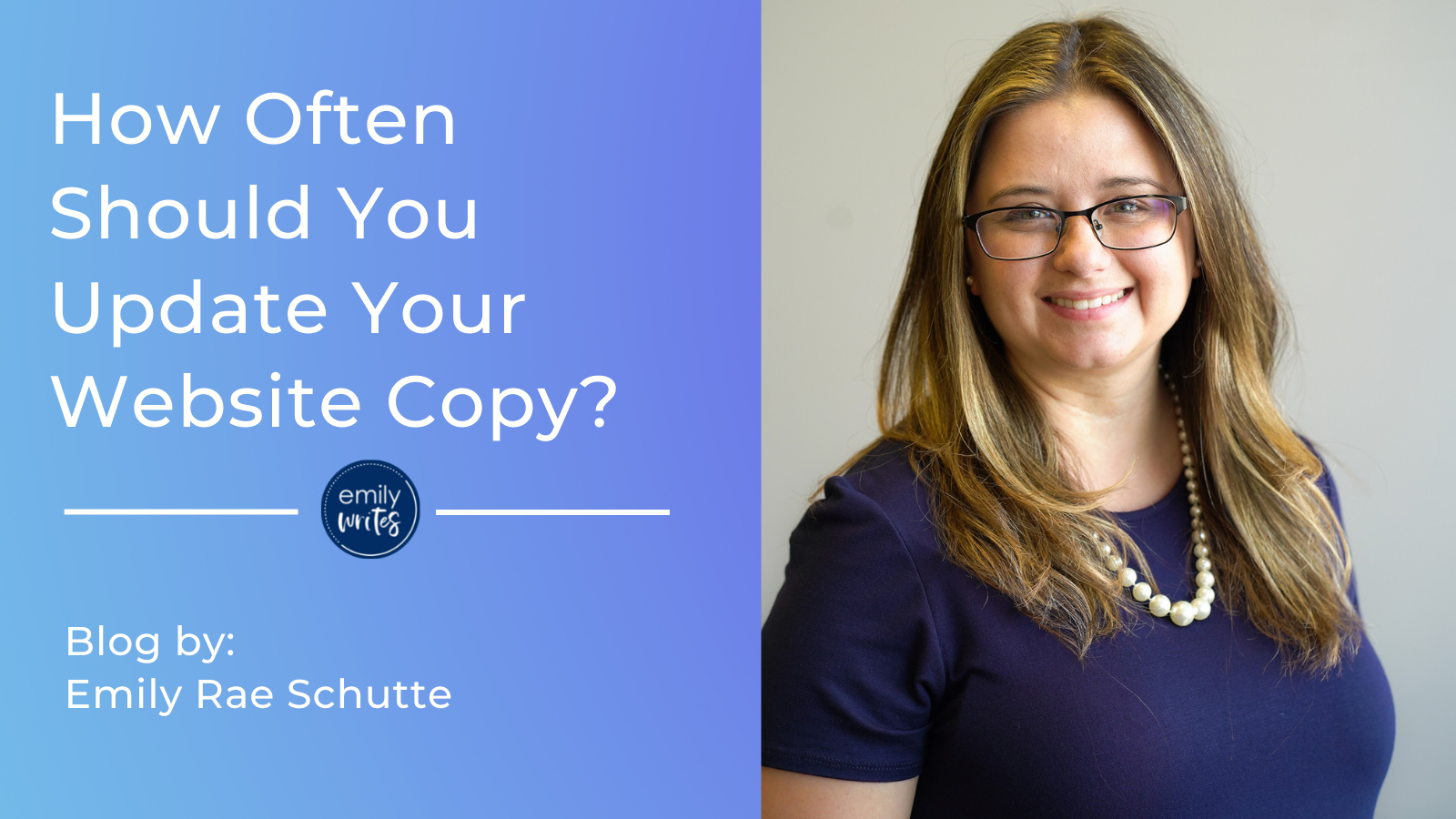We can all agree that having a website is pretty much the minimum standard for any business. But how frequently that website needs to be updated is open for discussion.
I’ve met entrepreneurs who haven’t done much to their site in years, and others who are making improvements every month. What’s the magic answer? How often should a small business website’s copy be revisited?
In my experience serving business owners and entrepreneurs, I believe there are four questions you should ask yourself when deciding whether it’s time to update your website copy.*
*Caveat: For SEO purposes, your website should ideally have fresh content added every week or month. This could be a blog, a podcast, an event, a press release, etc. Here’s an article to read more about the importance of regular content updates. Today’s blog is going to focus on the primary copy of your site! If you do need help with fresh, consistent, well-written content, I offer blog writing services.
Question #1: Have Your Products or Services Changed?
The most obvious reason to rewrite portions of your website is when you add, eliminate, or change a product or service. Your website needs to reflect your current offerings to be a reliable and credible resource for your business.
For each product/service, make sure website visitors get a clear picture of what it includes and how they can purchase from you. The copy should be descriptive, concise, and never vague.
Your products and services might each have their own subpages, but I challenge you to also update your website’s homepage to reflect your best offerings. Most people will only spend time on your homepage. Make sure you grab their attention!
Question #2: Have Your Primary Products or Services Changed?
Consider where most of your revenue comes from, or which products/services you would like to grow. Got that offer in mind? Now, your homepage should be written so that it points directly to it!
Keep in mind that your “primary” products or services do not necessarily have to be your bestsellers (yet!) but should be where you see your business heading in the next year or so. You can still highlight your other offers on separate pages.
By the way, this also includes the types of testimonials you use on your website. Don’t feature testimonials, even great ones, that speak to parts of your business that are no longer relevant for current website visitors. It creates unnecessary confusion.
Question #3: Has Your Brand Story Changed?
Most people have a hard time writing about themselves, which is why we often take a “one and done” approach to our About page. Your brand story doesn’t really change… or does it?
The truth is that your brand story is constantly evolving. Your About page should be written to reflect who you currently are, not where you started. Here are some examples:
- You began as a photographer but now you lead photography classes, too.
- You used to be a solopreneur but now you have a team.
- You started your business as a side hustle but now it’s a full-time venture.
- You began by serving a specific audience but have since expanded, narrowed, or pivoted.
Try to avoid time-specific references in your About copy, such as “7 years in business” or “my 5-year-old son.” Those sentences will have to be updated every year. Instead, say “business founded in 2015” and “my young son” to help your copy remain timeless.
Also, consider adding recent awards and accomplishments to this page, too. Your main goal with your About page is to build credibility.
Question #4: Is the User Experience Confusing?
I could write an entire article on this topic (oh wait, I have!) because far too many websites do not point users in a clear direction.
Make sure your website copy directs users to one primary call to action (CTA), and an optional secondary CTA. Confusing or hidden CTAs frustrate website visitors and result in fewer purchases or bookings. This blog digs into how StoryBrand underscores the importance of one clear call to action and also provides examples of primary and secondary calls to action.
Next, make sure you’re writing your website to your target audience – not to the masses. Trying to appeal to everyone is like shooting darts while wearing a blindfold. Pinpoint who you’re speaking to, and then write your website copy just to them. You want people to immediately see themselves in your copy and keep reading, or immediately realize it’s not for them and click away.
Finally, consider wrapping up all the miscellaneous information you want your website visitors to know in an FAQ section. When I’m writing websites for clients, we often have a lot of “but what about this?” moments that just make sense to compile into simple Q&As.
So… to answer the question “How often should you update your website copy?”, a good rule of thumb is to update it at least once a year. However, if you answered yes to any of the four questions above, then it’s time to update your website copy!
Do You Need a Professional Website Copywriter?
Is it time to update your website copy? I’m here to help!
With dozens of website rewrites under my belt, I love cutting to the heart of exactly what businesses do and turning that into compelling copy. Please book a no-obligation consultation with me so we can discuss what a website rewrite could look like for you and your business!

